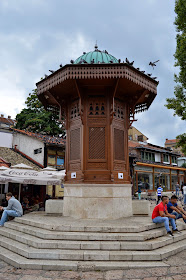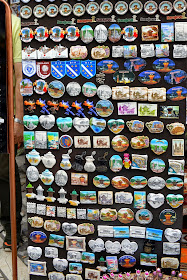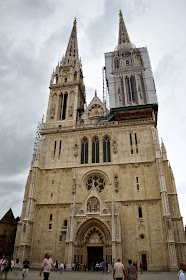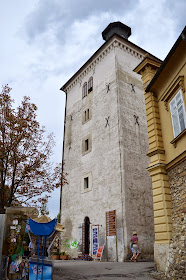I reached Zagreb, queued up for the toilet, came out to find only one luggage rotating on the conveyor belt...and it wasn't mine. After quickly asked one of the workers there where to find the lost & found counter, I went on my way. I passed by the Qatar Air counter on my way to find the Lost & Found counter, so I stopped and asked to check. Upon seeing me, the staff behind the counter told me my luggage was left in Doha.
Long story short, lodged a report and request for them to forward it to Sarajevo, nothing else could be done, so I took a bus and went out to see Zagreb city. Before the trip, I was checking for luggage locker to deposit my backpack and found out online that there isn't any in the airport due to some regulations. The plan was to lug the bag and deposit it at the bus station in the city. The positive outcome of this delayed baggage? It eliminated the need to hunt for luggage deposit. ;)
There was a Tourist Info office at the airport but it was closed when I was there, but getting a bus to the city wasn't difficult. The airport bus is parked outside of the main arrival terminal. The trip with the
airport bus to the main bus station takes about 30 minutes. Once you reached the main bus station, there will be tram connection to the city centre and train station.
One way ticket costs 30Kn but
return ticket costs only 40Kn. I had a blond moment and bought a one way ticket :( but as fate has it, I found 20Kn in the city ;)
 |
| Tram Network Map |
Tram lines 2, 5, 6, 7 and 8 run by the bus station and you can buy
tram ticket (tramvajska karta), single ticket (10Kn) or a pack of tens at a Tisak (newspaper kiosk). If you take the airport bus to the bus station (Autobusni Kolodvor), there is a Tourist Info nearby, as well as a Tisak. If you want to get to Trg Bana J. Jelacica, take
tram number 6 (towards Crnomerec) and exit at the fifth station (Trg Bana J. Jelacica). From memory, it was the one further away the bus station. You would need to validate your ticket on the tram, the validate machine is usually on the first carriage. The rest are mostly for the tap cards.
 |
| Zagreb City Map |
Ok, now back to why do I specifically write about Trg Bana Jelacica? Because... if I only have time to see one thing in Zagreb, I wanted to see this.
Yes -
St Mark's Church (Trg svetog Marka). Church of St Mark is a 13th century three-aisled Romanesque church. The roof tiles were decorated with the coats of arms of the Triune Kingdom of Croatia, Dalmatia and Slavonia on the left, and the emblem of Zagreb on the right.
I actually have enough time for more than St Mark's Church and followed the route suggested on the map. I've cropped the above map for a bigger picture.
Once the tram reached Trg bana Jelacica, you won't miss it. The status is really quite noticeable.
Trg bana Jelacica or Ban Jelacic Square was the city's commercial heart since 1641. The square was officially renamed to honour Ban ("Governor") Josip Jelacic. Ban Josip Jelacic was a general in the Austrian army and governor of Croatia from 1848 to 1859. He abolished serfdom and held the first ever elections for the Croatian Sabor or Parliament. Jelacic also helped Austrian forces put down the Hungarian Revolution of 1848 in the hope that this would lead to greater autonomy for Croatia. Aside from this statue and a square to his name, his portrait currently graces one side of the 20Kn banknote.
Going up the road on the right of the statue, one would see the
Cathedral of the Assumption of the Blessed Virgin Mary.
This church is characterized by its soaring twin towers (somewhat), the other one was under restoration. :P
I met up with K after she made her way here too and we entered the cathedral together and lighted a candle. I didn't go in when I walked by earlier.
Next up was
Dolac Market. I would love to walk and poke my nose around this market, unfortunately we were there on a Saturday where the market finished at 2 pm. My flight touched down passed 2 pm and by the time I reached the square, this was the only stall that was still opened.
I only found about this Stone Gate after reading up on Zagreb. This
Stone Gate (Kamenita vrata) was the only old town gate that has remained intact. It was built in the Middle Ages and assumed its final form after being rebuilt in the 18th century.
Under the arch of the gateway is a chapel dedicated to the Virgin Mary. It holds a painting of the Virgin that was miraculously saved from a devastating fire in the 1731. There were quite a few patrons praying at the time of my visit, so I didn't take any closed up photos as it felt kind of intruding given the smallish space.
St Mark's Church was the next monument according to the route but I have jumped the gun and put it up earlier.
The final monument on map was this
Lotrscak Tower.
Lotrscak Tower is the only preserved medieval tower from the 13th century fortifications and undergone slight modification in the 19th century. It was said that the bells of the Lotrscak tower were used to summon the townsfolk to return to the town at sunset when the gates were locked for the night. Nowadays Lotrscak housed a cannon which is fired every day at noon. Needless to say, I didn't hear that either.
From here, there are a few steps options all leading back to the Trg bana Jelacica. There was also some food and souvenir stalls nearby. After taking some photos from the top of the hill, I walked back down.
While I was waiting for friend to reach the square, I went to shop for some emergency clothing for the next day. I must say I was fairly optimistic that my luggage would reach Sarajevo the next day though friend was totally apprehensive. She was worried that we would end up chasing the luggage all the way till Poland :P
We left Zagreb the same night, taking a flight to Sarajevo.
Side note: Have you ever had experience when you move things to a safer or another place only to forget where the safer place is? :P























































